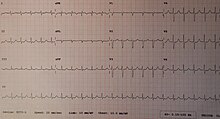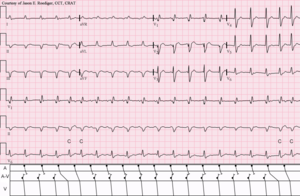| Junctional tachycardia | |
|---|---|
 | |
| ECG showing junctional tachycardia. Narrow complex QRS. No P waves. Heart rate fast. | |
| Treatment | Amiodarone to control the rhythm, electrical cardioversion is not used. |
Junctional tachycardia is a form of supraventricular tachycardia characterized by involvement of the AV node. [1] It can be contrasted to atrial tachycardia. It is a tachycardia associated with the generation of impulses in a focus in the region of the atrioventricular node due to an A-V disassociation. [2] In general, the AV junction's intrinsic rate is 40-60 bpm so an accelerated junctional rhythm is from 60-100bpm and then becomes junctional tachycardia at a rate of >100 bpm.

Cause
It can be associated with digitalis toxicity. [3] It may also be due to onset of acute coronary syndrome, heart failure, conduction system diseases with enhanced automaticity, or administration of theophylline. [4]
Diagnosis
On an EKG, junctional tachycardia exhibits the following classic criteria: [2]
- P-Waves: The p-wave may be inverted in leads II, III and aVF or may not be visible
- Narrow QRS complexes (which is consistent with arrhythmias that conduct through the ventricles using the His-Purkinje system and often originate from the atria or AV junction.)
It can coexist with other superventricular tachycardias due to the disassociation between the SA node and the AV node. [ citation needed]
Forms of junctional tachycardia include junctional ectopic tachycardia (JET) and atrioventricular nodal re-entrant tachycardia (AVNRT) which can be distinguished by performing electrophysiological studies. [5]
Treatment
Amiodarone is used to control the rhythm. Electrical cardioversion is not used.[ citation needed]
See also
References
- ^ "junctional tachycardia" at Dorland's Medical Dictionary
- ^ a b ROSEN, KENNETH (1973). "Junctional Tachycardia: Mechanisms, Diagnosis, Differential Diagnosis, and Management" (PDF). Circulation. 47 (3): 654–664. doi: 10.1161/01.CIR.47.3.654. PMID 4571060. Retrieved March 1, 2015.
- ^ "Junctional Rhythm: Overview - eMedicine". Retrieved 2008-12-21.
- ^ Aehlert, Barbara (2013). ECGs Made Easy (5th ed.). Elsevier. p. 160. ISBN 9780323170574.
- ^ Srivathsan K, Gami AS, Barrett R, Monahan K, Packer DL, Asirvatham SJ (January 2008). "Differentiating atrioventricular nodal reentrant tachycardia from junctional tachycardia: novel application of the delta H-A interval". J. Cardiovasc. Electrophysiol. 19 (1): 071004055652013––. doi: 10.1111/j.1540-8167.2007.00961.x. PMID 17916156. S2CID 25084446.